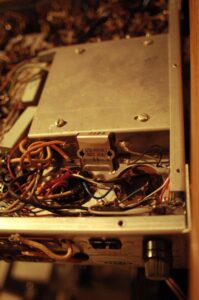In Part One, (Issue 127), J.I. told us about being suddenly locked down and without an amplifier for his music system, necessitating his purchase of a vintage H.H. Scott 299 stereo integrated amplifier. However, the unit wasn’t quite ready for prime time...
The H. H. Scott Type 299 integrated amplifier I purchased was designed for American power, so in order to use it with the 230 VAC in my home in Europe, it needed a step-down transformer. Fortunately, I had one in my parts stash.
To not risk destroying a good set of loudspeakers, I always try unknown amps on dummy loads first. The 299 powered up with no smoke, sparks, explosions or fire, but the output tube current was at 52 mA per tube, grossly exceeding the maximum plate dissipation of the tubes. It was promptly adjusted down to safe levels by means of the negative bias voltage adjustment trim pot, conveniently located at the rear panel, and the amp was powered off for further investigation.
 H. H. Scott Type 299 front panel. Photo courtesy of Agnew Analog Reference Instruments.
H. H. Scott Type 299 front panel. Photo courtesy of Agnew Analog Reference Instruments.
I had a massively overrated silicon rectifier bridge of similar physical dimensions in stock, so this was soldered on. Tube bias was then set accurately along with DC and AC balance and the amp was finally ready to rock.
How is that for “fully functional?”
Frankly, unless I’ve paid a very handsome sum of money to a known, suitably skilled engineer who verifies upon testing by scientific means that something really works, then I just assume it doesn’t. “Fully working” in the context of an online auction for vintage audio equipment should be taken as nothing more than, “all parts appear to still be there and the lights go on.” I was actually quite pleased that I only had to replace a rectifier and recalibrate.
I was now finally ready to listen to music at home, after about a month of not having any opportunity to do so!
The Scott amp was promptly hooked up to a pair of vintage KEF Model 104aB loudspeakers, built into custom cabinets, with upgraded crossovers.
One of my Thorens turntables was set up next to it, wearing an SME 3009 tonearm. I was divided between using a Shure V15 III moving magnet cartridge, or a van den Hul MC-Two high-output moving coil. Both cartridges are excellent matches for the SME tonearm and while I personally prefer the moving coil system, I was worried that its output might be too low for the Scott’s phono stage.
On the other hand, this would be a good test to see how noisy the phono stage really is, so I decided to try the van den Hul cartridge.
At first there was a bit of a hum, but in the process of restoring the 299 I had left the input tube screening cans (the metallic shields that go over the tubes) off, to be able to see the internal elements of all the tubes, to ensure that all the filaments lighted up, that there was no red color on the plates, no arcing and no other serious warning signs. As soon as the screening cans were replaced, the hum disappeared and I was surprised to hear how quiet the phono stage was! I wouldn’t have expected that from a 1950s 12AX7-based design, in an integrated amplifier that was never intended for moving coil cartridges!
I started with Muddy Waters’ “I Feel Like Going Home,” a monophonic recording dating from 1948, originally released by Leonard and Phil Chess as a 78 RPM record on their Aristocrat label. I had the Chess Records compilation of unissued Muddy Waters recordings on a 33-1/3 rpm LP at hand, so I switched one of the knobs on the 299 to the Monophonic Records position and the other one to RIAA EQ.
Conveniently, the Scott amp also offers a “EUR 78” position on the input selector knob, as well as a “NARTB Tape” position. This allows 78 RPM shellac records to be correctly reproduced (even though there were many different equalization curves used throughout the 78 RPM era and the speed was often not 78 RPM!) and even allows the reproducing head of a tape machine to be directly connected to the Scott amp, for all-tube tape playback! I will certainly be trying these features out in the near future“I Feel Like Going Home” features Muddy Waters on guitar and vocals, and Big Crawford on bass. It is simple and minimalistic, yet immensely powerful. The all-tube recording really came to life on the all-tube playback system and offered the most “genuine” reproduction of this recording I have heard to date. Full-bodied and extremely pleasant, with no hint of harshness on the aggressive slide guitar parts, harshness that I have often experienced on other systems.
I was now ready to move the knob to the “Stereo” position and try out something more…stereophonic! What better way to enjoy a 1958 American amplifier than some good ole Red Simpson? I have the two trucker-country records he released, featuring tunes like “Truck Daddy,” “Diesel Smoke, Dangerous Curves” and “A Tombstone Every Mile.” I always found these recordings to be a very good representation of the sound and vibe of the instruments involved, but the Scott really rode them curves with no hint of burning rubber! Yee-haw!
I took off my Stetson hat, put the Colt 45 back in the holster, and moved on to A&M Records-era Joan Baez, Diamonds and Rust from 1975. I wanted to push that Scott amp harder, find its limits, hear it collapse. But it didn’t!
Quite the opposite, in fact.
My wife Sabine and I both sat there with jaws dropping at the lifelike rendering of Joan’s voice, the impressively solid stereo image, the effortless low-frequency extension, and even how loud it could go, all from a compact amplifier that does not require a forklift truck to move and is only rated at 20 watts per channel!
By now I was determined to find a recording that would push that little amp over the edge.
So I dug out my secret weapon: Sheffield Lab LAB 7: Wagner, the Ride of the Valkyries track. Erich Leinsdorf conducting Los Angeles Philharmonic, recorded direct-to-disk at MGM studios in 1977.
Even there, the Scott held its own, with a very respectable rendering of the soundstage, impressive midrange detail and excellent dynamics, and it was more than able to deliver the realism of the powerful brass that makes this record stand out.
It should be noted that this is a recording I am intimately familiar with. I have used it as a reference on a wide range of ultra-fi studio monitoring systems. I have heard other systems do better with it, but those were all much larger systems, driving much larger loudspeakers in rooms with highly controlled acoustics, all at price tags that would dwarf many a small country’s GDP.
For its size, vintage and price, the Scott is about as impressive as it gets!
The listening session continued until late into the night, but despite my best efforts, I did not manage to find a recording that this amp could not deal with.
 The insides of the Scott Type 299: No printed circuit boards, but point-to-point wiring instead! Photo courtesy of Agnew Analog Reference Instruments.
The insides of the Scott Type 299: No printed circuit boards, but point-to-point wiring instead! Photo courtesy of Agnew Analog Reference Instruments.
The next day, I was somewhere else in the house when Sabine decided to put on a record she liked: Roxette’s Joyride.
Not exactly my musical taste and not really a record I ever found impressive-sounding. However, even from a distance, there was something to it that made me stop what I was doing and slowly allowed myself to be pulled into the living room by the sound I was hearing.
Suddenly, this record sounded massive. I had never heard it like that before. There was detail there I had never noticed before, while some of the not-so-pleasant aspects of the sound were magically gone. For the first time, I was able to sit through the whole album and appreciate that, regardless of musical tastes, Marie (the singer) was gifted with a very good voice, which the Scott really brought to the forefront. (Note: Marie Fredriksson left this cruel world on December 9, 2019, after a long battle with brain cancer.)
I would not say that the Type 299 is an exceptionally accurate amp, although it does sound quite detailed, especially in the midrange. It is definitely a very musical amplifier that can offer many hours of pleasure with a very wide range of repertoire. One can listen to all kinds of music (or “both kinds of music,” country and western, if you were into Red Simpson and Hank Williams: https://www.youtube.com/watch?v=cSZfUnCK5qk) and it will do a decent job of it. If you have very inefficient loudspeakers and need to fill a concert hall, it is probably not the right choice, but for most domestic living rooms with most reasonable loudspeakers, you would be hard-pressed to find something as good for that kind of money.
The 299 has the ability to highlight vocals, guitars and string sections in a very natural way, bringing out the pleasant details of a recording while at the same time not rubbing unpleasant details in your face. Add to that its ruggedness and the fact that there’s nothing in there that you wouldn’t be able to find as a spare part if it breaks, and it makes for a very attractive proposition at a very reasonable cost.
Sometimes I feel it is of utmost importance that designers and manufacturers nowadays look back at what had already been achieved in the 1950s (and in other sectors outside audio, even earlier), to seek inspiration and to determine whether what they are doing can really be considered a worthy improvement over the already high standards set back then. The phrase “The Golden Age of Hi-Fi” is more than justified by products like the H. H. Scott Type 299 and it goes a lot deeper than the color scheme of the front panel!
At 62 years of age, the 299 is nowhere near ready for retirement, still performing on a level that many “youngsters” should be looking up to.
This may have all started out of necessity due to the lockdown, but this Scott is not going anywhere anytime soon. It has rightfully earned its place in my living room!
 Serving suggestion: Best enjoyed by the fireplace. Photo courtesy of Agnew Analog Reference Instruments.
Serving suggestion: Best enjoyed by the fireplace. Photo courtesy of Agnew Analog Reference Instruments.


